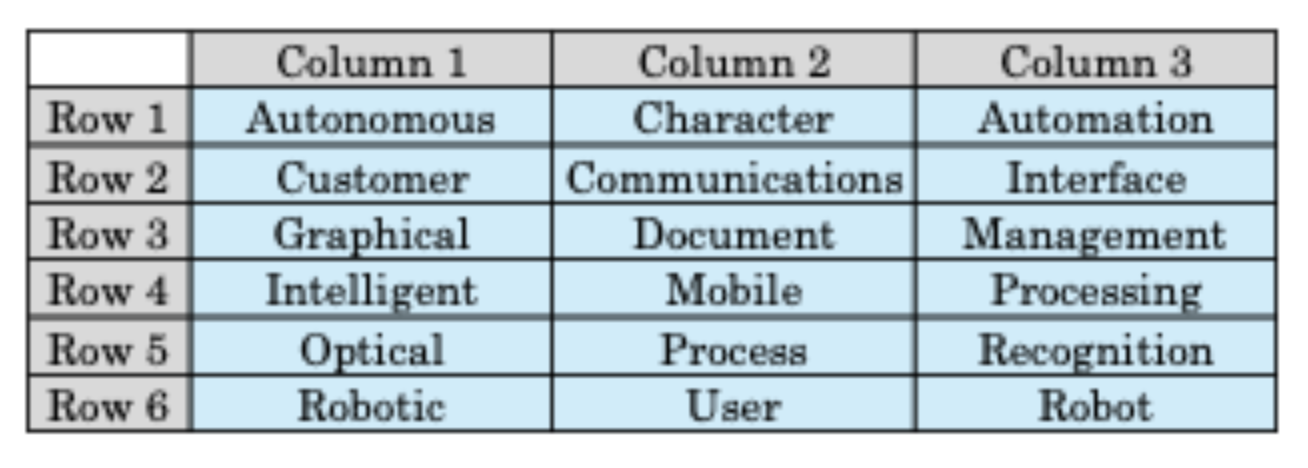Introduction
When I was a young Applications Analyst for Linotype on Long Island, I was flabbergasted by the number of three-letter acronyms (TLAs) that had developed around PostScript and prepress. (Pre-press was still hyphenated at the time, which gives you an idea of how long ago this was.) For fun, I created a three-letter acronym generator with the help of some of my work colleagues. If memory serves, we used FileMaker Pro to make it. We selected three sets of words to choose from. All you had to do was press a button and a new acronym would automatically appear, picked randomly from those sets of words. Even though they were randomly chosen and often nonsensical, sometimes they seemed eerily similar to the ones we used every day in our work.
Artificial Intelligence and Robotic Process Automation
This TLA memory came back to me not long ago when I was working on a white paper about the role of artificial intelligence (AI) in the growth of robotic process automation (RPA). It seemed like everything I wrote about turned out to be an acronym too.
In case you were wondering, RPA refers to business process automation tools that use software robots (commonly referred to as “bots” or AI agents). As opposed to traditional workflow automation tools, which are dependent on software developers to create a list of actions to automate a task and interface with computer systems, RPA systems develop action lists by tracking the performance of a system’s user through that system’s graphical user interface (GUI). In other words, they watch what you are doing and figure out how to replicate those actions. Tools using RPA can work with data across various software applications. For example, some RPA systems identify when an e-mail arrives with an invoice and then extract the data and transfer that data to a bookkeeping system.
RPA should not be confused with Rule-Based Automation (RBA). Rule-based automation uses predefined and logical rules to manipulate data. RBA programs tell systems what actions should be taken when certain conditions are met. RBA can be used to automate routine any repetitive tasks in which the process has been studied and defined. RPA, on the other hand, gains its power through its ability to learn by observing a user.
You will often hear the term “Intelligent Process Automation (IPA)” in discussions of RPA. IPA uses AI to automate business processes, including everything from simple repetitive tasks to complex workflows. One key piece of IPA is that it can learn and adapt to changing business needs. As defined by Cognizant Technology Solutions, the information technology services and consulting company: “Intelligent process automation combines RPA with process mining, OCR [optical character recognition], analytics, and AI to create business process automation that thinks, learns, and adapts.”
Where AI-enabled RPA tends to be used in production printing is in workflow automation solutions for applications like color management, inventory management, job onboarding, scheduling and status, order processing and pricing, preflighting, prepress, and preventative maintenance. All areas of workflow automation are potential candidates for RPA. Software bots/AI agents in RPA applications may work alone or in some cases with a hardware partner like an Autonomous Mobile Robot (AMR) for paper handling or logistics.
Those folks in direct mail or transactional printing applications are likely to see RPA being used for tasks like document conversion, which is particularly important for customers in industries like banking, finance, and insurance. There are also those who expect that AI and RPA will be leveraged in Customer Communications Management (CCM) and Customer Experience Management (CXM) software platforms.
It is becoming increasingly clear that while RPA and AI can solve different types of problems, they become particularly powerful when combined. This is especially the case when they include applications like intelligent document processing (IDP) for unstructured data coming in the form of photos, documents, and e-mails. Companies looking to implement RPA need strong information technology (IT) teams to guarantee a positive return on investment (ROI).
The Bottom Line
As you can see from the preceding paragraphs, many industries love to use acronyms. Unfortunately, though, these acronyms can sometimes isolate newcomers who are struggling to learn and understand the lingo. In your sales and marketing efforts, try to avoid using acronyms unless they have come into common usage. Even high-visibility acronyms like AI may be befuddling to some customers. Those whose first language is not English may find acronyms particularly challenging. Keep this in mind as you write copy for your advertisements, and ask yourself—is it really that onerous to write out or say the full description rather than relying on a potentially-confusing industry acronym?
Bonus: The TLA Challenge
Here’s a little puzzle for you! The table below has three columns. Each column has six words. Can you find six industry acronyms by picking one word from each column, without reusing any of those words? Hint: Each acronym is mentioned in this blog, but you have to pick the correct six acronyms to avoid reusing any of the words in columns 1, 2, and 3.

Author bio: Jim Hamilton of Green Harbor Publications is an industry analyst, market researcher, writer, and public speaker. For many years he was Group Director in charge of InfoTrends’ Production Digital Printing & Publishing consulting services. He has a BA in German from Amherst College and a Master’s in Printing Technology from the Rochester Institute of Technology.


